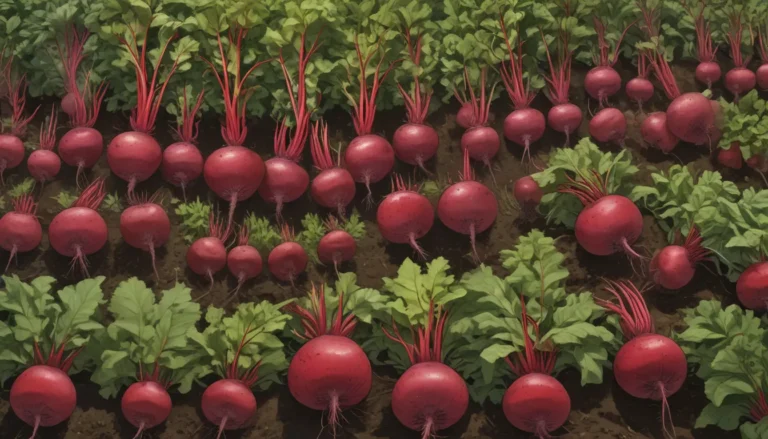Companion Planting Made Easy: A Comprehensive Guide to Growing Lettuce

Are you tired of dealing with pests, weeds, and other common garden issues while trying to grow lettuce? If so, I have good news for you – companion planting can help alleviate many of these problems and make your gardening experience much more enjoyable.
In this detailed guide, we’ll explore the benefits of companion planting for lettuce, provide a list of recommended companion plants, and explain why these plant partnerships work so well. From pest control to environmental benefits and soil improvements, we’ll cover it all to help you create a successful garden filled with healthy lettuce and thriving companions.
How Does Companion Planting Benefit Lettuce?
Before we dive into specific companion plant recommendations, let’s first understand the concept of companion planting and how it benefits lettuce.
Companion planting involves grouping plants together to create a supportive growing environment for all species involved. By strategically selecting companion plants, you can improve pest control, enhance environmental conditions, and promote soil health, all of which contribute to the overall success of your lettuce crop.
Pest Control
One of the key benefits of companion planting is enhanced pest control without the need for harmful chemicals. By planting certain companion species, you can attract predatory insects that feed on common lettuce pests like caterpillars, worms, and slugs. Additionally, companion plants can emit scents and colors that repel unwanted insects, creating a natural defense system for your lettuce.
Environmental Control
Companion plants can also help regulate environmental conditions such as heat, sun exposure, and water availability, all of which can impact lettuce growth. Some companion species have strong root systems that improve soil structure and prevent erosion, while others can provide shade or increase water retention, creating a more hospitable environment for lettuce to thrive.
Soil Improvements
Lettuce plants belong to the Lactuca genus and require nitrogen-rich soil for optimal growth. By selecting companion plants that fix nitrogen or add organic matter to the soil, you can create a nutrient-rich growing environment for your lettuce. Additionally, companion species that aerate the soil can help improve drainage and enhance overall soil health, supporting the growth of healthy lettuce plants.
Now that we’ve covered the basics of companion planting, let’s explore some of the best companion plants for lettuce and how they can benefit your garden.
Best Companions for Lettuce
When it comes to choosing companion plants for lettuce, the options are plentiful. From alliums to flowers, fruits, vegetables, grains, and herbs, there are many plant species that can complement and support your lettuce crop. Let’s take a closer look at some of the recommended companions for lettuce and why they make good planting partners.
Alliums
Alliums, such as garlic, onions, and shallots, are excellent companions for lettuce due to their strong aromas and pest-repelling properties. By interplanting alliums with lettuce, you can create a barrier that deters aphids, beetles, and other insects while also breaking up compacted soil with their bulbous roots.
Recommended Allium: ‘Zebrune’ Shallots – These mild and slightly sweet shallots are a great addition to any garden and can help protect your lettuce from unwanted pests.
Flowers
Flowers not only add beauty to your garden but can also serve as effective companion plants for lettuce. Species like amaranth, calendula, and marigolds act as trap crops for pests, attract beneficial insects, and provide additional protection and support for your lettuce crop.
Recommended Flowers:
– Amaranth – Acts as a trap crop for beetles and other pests while adding a pop of color to your garden.
– Calendula – A natural slug repellent that also attracts pollinators and provides healing qualities.
– Marigolds – Known for their insect-repellent properties, marigolds can ward off a variety of garden pests and support the growth of other vegetable crops.
Fruits and Vegetables
Certain fruits and vegetables make excellent companions for lettuce due to their pest-repelling or soil-improving properties. Carrots, peas, radishes, strawberries, and turnips are just a few examples of species that can enhance the health and productivity of your lettuce crop.
Recommended Fruits and Vegetables:
– Carrots – Help aerate the soil and improve drainage, benefiting neighboring lettuce plants.
– Peas – Fix nitrogen in the soil and provide shade for delicate lettuce foliage in hot climates.
– Strawberries – Shield lettuce from excessive sun exposure and reduce water loss through evaporation.
– Turnips – Trap nuisance insects and provide additional support for lettuce growth.
Grains and Cover Crops
Cover crops like clover and buckwheat can contribute to soil health and fertility, making them valuable companions for lettuce. These species fix nitrogen, improve soil structure, and attract beneficial insects, creating a more sustainable and productive growing environment for your lettuce plants.
Recommended Grains and Cover Crops:
– Clover – Fixes nitrogen in the soil and acts as a cover crop to enhance soil health and support lettuce growth.
– Buckwheat – Adds calcium to the soil, breaks up compacted soil, and attracts beneficial insects like braconid wasps.
Herbs
Aromatic herbs like basil, catnip, dill, and mint can serve as natural pest repellents and flavor enhancers for your garden. These herbs produce oils that deter common garden pests and can be interplanted with lettuce to create a more resilient and diverse planting scheme.
Recommended Herbs:
– Basil – Repels insects and adds flavor to salads and other dishes, making it a versatile companion for lettuce.
– Catnip – Deters pests and attracts beneficial insects like braconid wasps, helping to protect lettuce from common pests.
– Dill – Acts as a multipurpose insect repellent and seasoning, enhancing the health and flavor of neighboring lettuce plants.
Bad Company
While there are many beneficial companions for lettuce, there are also some species to avoid planting near your lettuce crop. Brassicas like broccoli, cabbage, and kale, as well as sunflowers, can have negative effects on lettuce growth due to allelopathic compounds that inhibit seed germination and plant growth.
Good Neighbors
By selecting the right companion plants for your lettuce crop, you can create a harmonious and productive garden that supports the growth and health of all species involved. Whether you’re looking to enhance pest control, improve soil health, or attract beneficial insects, companion planting offers a sustainable and effective solution for growing healthy and vibrant lettuce plants.
What’s your companion planting plan for the upcoming gardening season? Share your ideas and experiences in the comments below to inspire other gardeners and learn from each other’s successes. We love to see your garden photos and hear your questions, so don’t hesitate to reach out for more information and support.
For more information on growing lettuce and creating a successful garden, check out these helpful resources:
– Plant Your Salad Greens Early: Tips for Growing Lettuce and Microgreens
– How to Be Successful with Your Lettuce Patch
– Grow Leaf Lettuce: Harvest Beautiful, Nutritious Salads from Your Own Backyard
With the right companions by your lettuce’s side, you can look forward to a thriving and bountiful garden that produces healthy and delicious crops all season long. Let companion planting be your guide to a successful and sustainable gardening experience.





